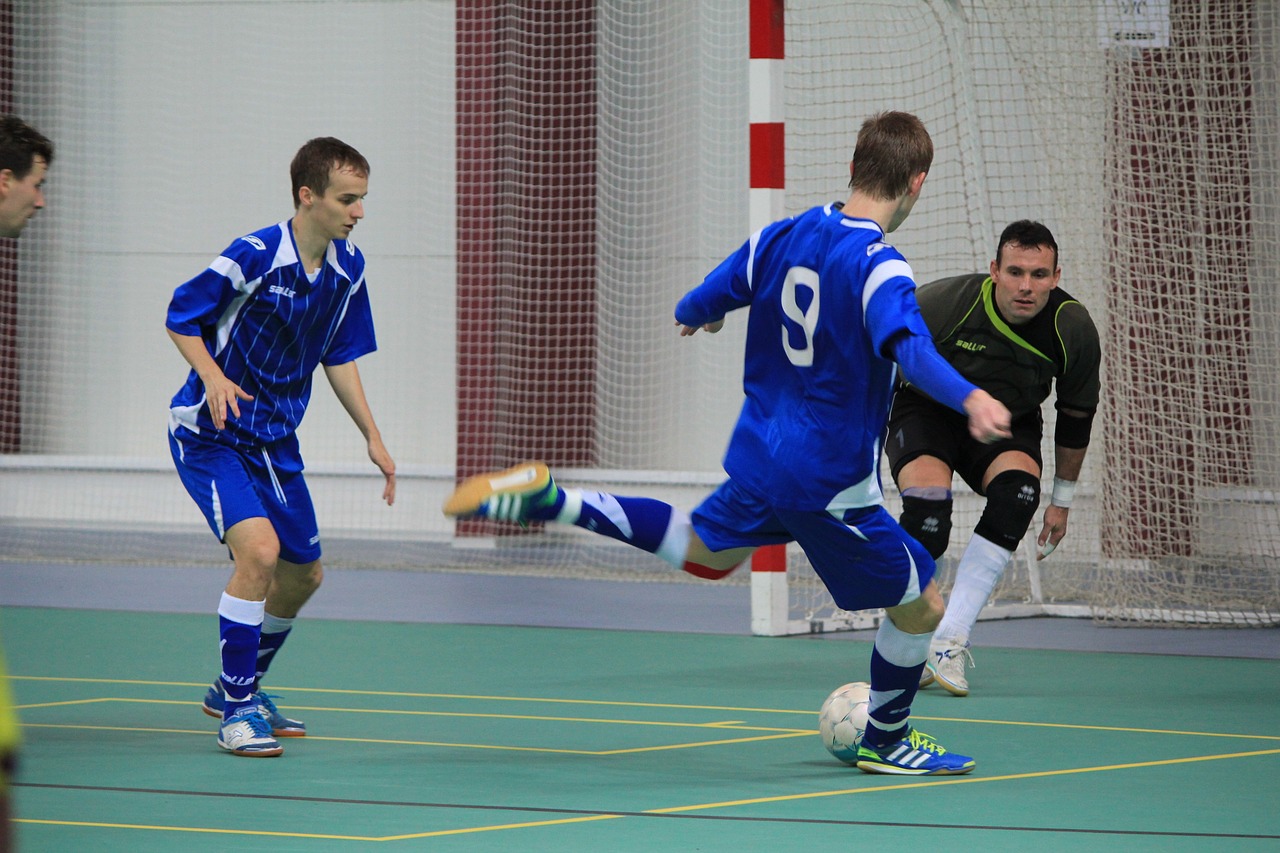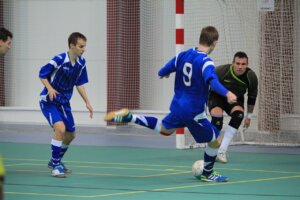Sometimes confused as merely indoor football (soccer), futsal is a distinct game that takes various elements from other sports to create a fun indoor game.
Definition of Futsal
Futsal is a variation of football played (mostly) indoors on a hard court slightly larger than a basketball court, featuring two teams of five players each, including a goalkeeper. It utilises a smaller, heavier, low-bounce ball and is acknowledged by FIFA as the official indoor football game. Futsal is contested with touchlines as boundaries and lacks walls or boards, at a brisker pace than football, enabling more ball touches and typically leading to increased scores. It is enjoyed in more than 100 countries globally by 12 million participants.
Origin and History
The origins of futsal can be traced back to 1930s Uruguay when a teacher named Juan Carlos Ceriani developed the game, initially intended for play on a basketball court. In formulating the rules, he borrowed the five-a-side team sizes and 40-minute match duration from basketball, pitch and goal dimensions from handball, and goalkeeper rules from water polo. The game rapidly spread across South America, where standardised rules were established, leading to the formation of the first international confederation in 1965. In 1989, FIFA assumed the role of the sport’s governing body and organised the inaugural World Cup in the Netherlands that January, with Brazil emerging victorious against the hosts in the final. The initial UEFA tournament took place in 1996 and was won by hosts Spain. Subsequently, a full UEFA European Futsal Championship occurred in 1999, with Russia claiming victory.
Futsal vs. Soccer
Many argue that futsal is football’s smaller sibling, and they might be right. Futsal is essentially a “football on a smaller pitch,” incorporating elements from other team sports like basketball (regarding the number of players), handball (concerning the court and goal size), and water polo (introducing the flying goalkeeper). Undoubtedly, futsal shares numerous similarities with football. This is evident in the fact that many footballers, regarded as the best in the sport’s history, started their careers playing futsal. Some even express a preference for futsal over football. It’s not surprising that the technically most proficient football nations, such as Argentina, Brazil, Portugal, and Spain, have a rich and widespread futsal tradition.
Playing Format
Futsal is played between two teams, each consisting of five players, one of whom is the goalkeeper. The game takes place on a hard court with touchlines as boundaries, and it lacks walls or boards. Here are some key aspects of the futsal playing format:
- Team Size: Each team comprises five players on the field, with no restrictions on substitutions during the match.
- Duration: Futsal matches typically consist of two halves, each lasting 20 minutes of actual playing time. There is a 10-minute halftime break.
- Scoring: Goals are scored when the entire ball crosses the goal line between the goalposts and beneath the crossbar. Each goal counts as one point.
- Kick-ins: Instead of throw-ins, players perform kick-ins to restart play when the ball goes out of bounds. The ball must be stationary on the touchline, and the player has four seconds to take the kick.
- Goalkeeper Restrictions: The goalkeeper has restrictions on how far they can venture out with the ball in hand. This limitation encourages faster ball circulation and dynamic play.
- Fouls: Futsal has a strict set of rules regarding fouls. Accumulation of fouls can lead to free kicks, with the defending team required to maintain a distance of at least 5 metres from the ball.
Court and Equipment
The futsal court, typically made of wood or artificial material, measures between 38–42 m (125–138 ft) in length and 20–25 m (66–82 ft) in width for international matches. Other matches may vary from 25–42 m (82–138 ft) in length and 16–25 m (52–82 ft) in width, with the condition that the length of touchlines exceeds that of goal lines. The standard international court size is 40 m × 20 m (131 ft × 66 ft), akin to a handball field, with a minimum ceiling height of 4 m (13 ft).
The penalty area, in front of each goal, is marked by quarter-circles with a 6 m (20 ft) radius from the goal line. A 3.16 m (10.4 ft) line connects the upper parts of these quarter-circles, forming the penalty area line. This area determines where the goalkeeper can handle the ball. The penalty mark is six metres from the goal line, and a second penalty mark at 10 metres is used for certain fouls.
Footwear with rubber soles completes the ensemble. Goalkeepers have the option of wearing long trousers and a distinctively coloured kit for easy identification. Elbow pads are permissible for goalkeepers due to the relatively hard playing surface, akin to a tennis or basketball court. Wearing jewellery or any items posing a potential danger to the player or others on the field is not allowed.
Rules and Regulations
Teams consist of 14 players, with five (including a goalkeeper) allowed on the pitch at any time, enabling rolling and unlimited substitutions. A ‘flying goalkeeper,’ an outfield player in a specialised shirt, can replace the regular goalkeeper. This power play tactic is employed to alter game dynamics, especially when pursuing goals. Each half spans 20 minutes, with a clock that halts during stoppages. Coaches can call a one-minute timeout in either half. In UEFA knockout games, extra time may occur, with two periods of five minutes each. A penalty shootout from the six-metre mark ensues if scores remain level after 50 minutes (or 40 in third-place play-offs).
Free kicks and penalties function similarly to football. After a team commits five fouls in one half, their opponents receive a free shot at goal from the second penalty mark, 10 metres out (commonly known as a double penalty). Four match officials include a referee on one touchline, a second referee on the opposite touchline (both can enter the pitch if needed), a third official monitoring substitutions and foul count, and a timekeeper liaising with the other officials. Players receive two yellow cards or a direct red for dismissal. Following a sending-off, the penalised team plays one man short for two minutes, returning to full strength immediately if they concede during that time.
Skill Development
Futsal skill development encompasses a multifaceted approach, emphasising technical proficiency, tactical awareness, and physical conditioning. Players should dedicate time to refining their ball control, dribbling skills, and precise passing techniques, particularly in tight spaces. Shooting abilities should be honed with various techniques, focusing on accuracy from different angles and distances. Tactical understanding is crucial, emphasising positional awareness, team formations, and execution of set plays. Goalkeepers should work on agility, reflexes, and distribution techniques. Incorporating small-sided games simulates match conditions and enhances quick decision-making and teamwork. Additionally, individual and team drills, coupled with continuous learning from professional matches, contribute to comprehensive skill development.
FAQs
How does futsal differ from traditional soccer?
Futsal differs from traditional soccer in various aspects, such as smaller team sizes (five players on each side), a smaller and harder ball, and playing on a hard court with touchlines instead of walls.
What are the key rules and regulations in futsal?
The key rules in futsal include the use of a flying goalkeeper, limited fouls before conceding free shots, and a quicker-paced game with two halves of 20 minutes each.
Are there specific skills emphasised in futsal compared to soccer?
In futsal, specific skills like close ball control, quick decision-making, and precise passing are particularly emphasised due to the smaller playing space and fast-paced nature of the game, setting it apart from soccer.




